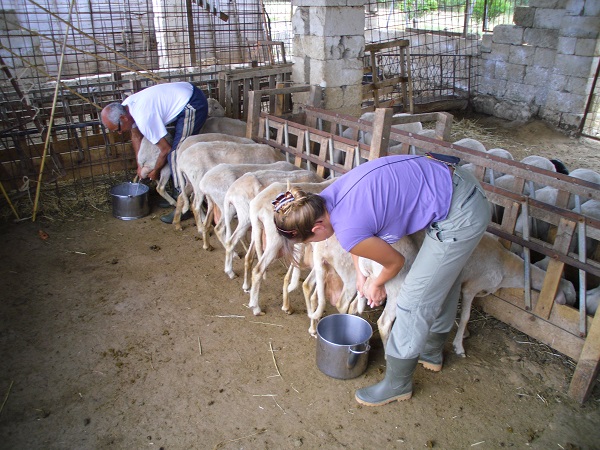
Sheep have been raised for milk for thousands of years and were milked before cows. The world’s commercial dairy sheep industry is concentrated in Europe and the countries on or near the Mediterranean Sea. The dairy sheep industry is in its infancy in the United States. There are approximately 200 dairy sheep farms in the U.S. They are found mostly in New England and the Upper Midwest. There are several large commercial sheep dairies in New York and California.
Sheep milk is highly nutritious, richer in vitamins A, B, and E, calcium, phosphorus, potassium, and magnesium than cow’s milk. It contains a higher proportion of short- and medium-chain fatty acids, which have recognized health benefits. For example, short chain fatty acids have little effect on cholesterol levels in people and make milk easier to digest. According to a German researcher, sheep milk has more conjugated linoleic acid (CLA) than the milk from pigs, horses, goats, cattle, and humans. CLA is a cancer-fighting, fat-reducing fat. The fat globules in sheep milk are smaller than the fat globules in cow’s milk, making sheep milk more easily digested.
Sheep milk can be frozen and stored until enough milk is available to sell or make cheese. Freezing does not affect the cheese-making qualities of the milk. Sheep milk has a higher solids content than goat or cow milk. As a result, more cheese can be produced from a gallon of sheep milk than a gallon of goat or cow milk. Sheep milk yields 18 to 25 percent cheese, whereas goat and cow milk only yield 9 to 10 percent. While sheep usually produce less milk than goats and much less than cows, sheep milk sells for a significantly higher price per pound, almost four times the price of cow milk. Most of the sheep milk produced in the world is made into cheese. Some of the most famous cheeses are made from sheep milk: Feta (Greece, Italy, and France), Ricotta and Pecorino Romano (Italy) and Roquefort (France). The U.S. is a large importer of sheep milk cheeses. Sheep milk is also made into yogurt and ice cream.
Dairy Sheep Breeds
While lactating ewes of any breed can be milked, as with other species of livestock, there are specialized dairy sheep breeds. Worldwide there are more than a dozen dairy sheep breeds, but only a few are available in the United States: East Friesian and Lacaune. Specialized dairy breeds produce 400 to 1,100 pounds of milk per lactation, whereas the milk production from conventional sheep breeds is only 100 to 200 pounds of milk per lactation. The East Friesian is the most common and productive breed of dairy sheep in the world. Their average production is 990 to 1,100 pounds per 220 to 240-day lactation.
Two other highly productive breeds of dairy sheep are the fat tailed Awassi and Assaf breeds from Israel. In France, the Lacaune is the breed of choice for making the country’s famous Roquefort cheese. Worldwide, most sheep are milked seasonally by hand. This is because many dairy sheep are raised in remote areas where no cow could survive. Modern sheep dairies use sophisticated machinery for milking: milking parlors, pipelines, bulk tanks, etc. Ewes are milked once or twice per day. In the United States, dairy ewes are managed in different ways. On some farms, ewes are not milked until their lambs have been weaned at 30 to 60 days of age. Another system allows lambs to suckle their lambs for 8 to 12 hours per day, after which time they are separated for the night and the ewes are milked the following morning. After the lambs are weaned at 28-30 days, the ewes are milked 2 times per day. Maximum milk yield is obtained when the lambs are removed from their dams within 24 hours of birth and raised on artificial milk replacer, as is common in Europe (with the East Friesian breed) and in cow and goat dairies.
This article was provided by Sheep101.info.
Fun Facts
The average U.S. dairy cow produces 22.5 quarts of milk each day. That’s about 16,000 glasses of milk per year enough for about 40 people. One cow can give 200,000 glasses of milk in a lifetime.
It takes approximately 1.4 gallons of milk to make 1 gallon of ice cream.
Cheese was first made over 4,000 years ago in Asia.
A cow has 4 stomachs: the rumen, where the food is first stored, the reticulum where food that has been more thoroughly chewed is stored once the cow has chewed the cud and has swallowed it; the omasum where extra water is squeezed out, and finally the food goes to the abomasum. Some of the digested food is then stored in the cow’s udder where it is made into milk.
Related Articles & Free Email Newsletter Sign Up
An Alpaca Can Be Both a Farm Animal and a Pet
How to Prepare Sheep for Healthy Lambing and Kidding
How to Prevent and Treat Goat Abscesses




Comment here